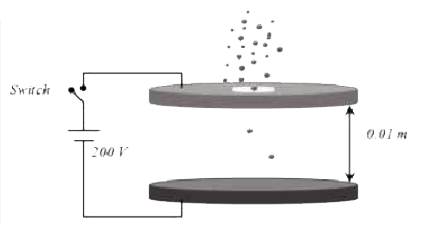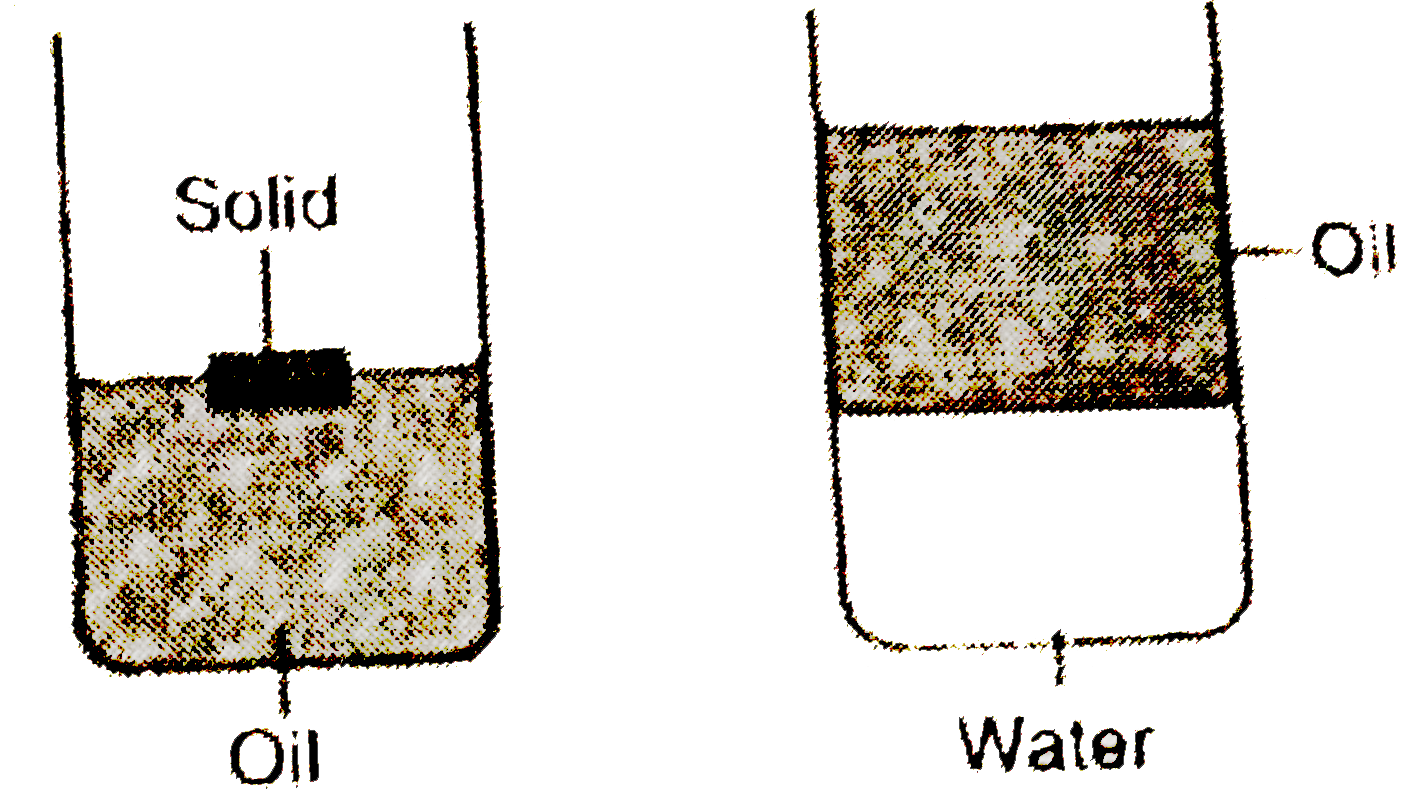Two large circular discs separated by a distance of 0.01 m are connected to a battery via a switch a shown in the figure. Charged oil drops of density 900kgm−3 are releasd through a tinly hole at the centre of the top disc . Once some oil drops achieve terminal velocity , the swith is closed to apply a voltage of 200 V across the disc. As a result an oil drop of radius 8×10−7 m stops moving vertically and floats between the discs. The number of electrons present in this oil drop is ________. (neglect the buoyancy force, take acceleration due to gravity =10ms−2 and charge on an electron (e) =1.6×10−9(C)

The correct Answer is:6
qE=mg
q=mgE=900×43π(8×10−7)3×10
=900×43π×512×10−21×10
2×104
N=900×43π×512×10−21×10
2×104×1.6×10−19
N = 6
Topper's Solved these Questions
- BOOK - JEE ADVANCED PREVIOUS YEARCHAPTER - JEE (ADVANCE) 2020EXERCISE - SECTION 26videos
JEE (ADVANCE) 2020
- BOOK - JEE ADVANCED PREVIOUS YEARCHAPTER - JEE (ADVANCE) 2020EXERCISE - SECTION 36videos
JEE (ADVANCE) 2020
- BOOK - JEE ADVANCED PREVIOUS YEARCHAPTER - JEE ADVANCEDEXERCISE - PHYSICS SECTION - IV Matrix Match Type2videos
JEE ADVANCED
Similar Questions
A beaker of radius r is filled with water (refractive index 43) up to a height H as shown in the figure on the left. The beaker is kept on a horizontal table rotating with angular speed ω. This makes the water surface curved so that the difference in the height of water level at the centre and the circumference of the beaker is h (h<<H,h<<r) as shown in the figure on the right . Take this surface to be approximately spherical with a radius of curvalture R . Which of the following is/are correct ? (g is acceleration due to gravity)
 01:51View Solution
01:51View SolutionA spherical bubbles inside water has radius R . Take the pressuere in the bubbled and the water pressure to be pv. The bubble now gets compressed radially in an adiabatic manner so that its raduis becomes (R - a) . For a<<R the magnitude of the work done in the process is given by (4πpoRa2)X. where X is a a constant and y=Cp/Cv=41/30. The value of X is
05:24View SolutionOne mole of a monatomic ideal gas is taken through a cycle ABCDA as shown in the P-V diagram. Column II gives the characteristics involved in the cycle. Match them with each of the processes given in Column I.
 01:18View Solution
01:18View SolutionIn Millikan's oil drop experiment, an oil drop mass 60 xx 10^(-6) kg is balanced by an electric field of 10^(6) V//m . The charge in coulomb on the drop, assuming g = 10 m//s^(2) is
View SolutionAn oil drop falls through air with a terminal velocity of 5×10−4sec viscosity of air is 1.8×10−5N−sm2 and density of oil is 900 kg m3 neglect density of air as compared to that of oil.
View SolutionA large drop of oil whose density is less than that of water, floats up through a column of water assume that the oil an the water do not mix. The coefficient of viscosity of the oil is η∘ and that of water is ηW the velocity of the drop will depend on
02:34View SolutionAn oil drop of charge of 2 electrons fall freel with as terminal speed. Calculate the mas of oil drop so, it can move upward with same terminal speed, if electric field of 2×103V/m is applied.
02:48View SolutionA solid of density 900kg/m3 floats in oil as shown in the given diagram. The oil floats on water of density 1000kg/m3 as shown.The density of oil in kg/m3 could be:
 03:11View Solution
03:11View SolutionWhat is the terminal velocity of a copper ball of radius 2.0 mm, which falls through an oil tank? Given that density of oil = 1.5×103 kg m−3, density of copper =8.9×103kgm−3 and viscosity of oil is 0.99 kg m−1s−1.
03:41View Solutionवायु में स्वतन्त्र रूप से गिरती हुई तेल की बूँद के सीमान्त वेग की गणना कीजिये। बूँद की त्रिज्या 0.01 मिमी है तथा तेल का घनत्व 1.1×103 किग्रा/मीटर 2 है। वायु का श्यानता गुणांक 1.8×10−5 सेकण्ड/मीटर तथा g = 9.8 मीटर/सेकण्ड 2 । वायु के घनत्व की उपेक्षा की जा सकती है।
02:39View SolutionAn oil drop of density 950 kg. m−3 and radius 10−6 m is falling through air. The density of air is 1.3kg.m−3 and its coefficient of viscosity is 181×10−7 SI unit. Determine the terminal velocity of the oil drop. [g=9.8m.S−2]
04:18View SolutionAn oil drop falls through air with a terminal velocity of (5xx10^(-4))/(sec) viscosity of air is 1.8xx10^(-5)(N-s)/(m^(2)) and density of oil is 900 kg m^(3) neglect density of air as compared to that of oil.
05:29View SolutionA glass of radius 10^(-3) and density 2000 kg m^(-3) fall in a jar filled with oil of density 800 kg m^(-3) .The terminal velocity is found to be 1 cm/s. Calculate the coefficient of viscosity of oil
02:13View SolutionAn oil drop of diameter 4 xx 10^(-6) m falls through air. iF the densities of the oil and air are 900 kg/m^(3) and 1.293 kg/m^(3) respectively and the coefficient of viscosity of air is 2.0 xx 10^(-5) Ns//m^(2) , then the terminal velocity of oil drop will be
02:15View SolutionAri oil drop, of 12 excess electrons is held stationary under a constant electric field of 2.55x104N/C in Millikan's oil drop experiment. The density of the oil is 1.26g/m3 Estimate the radius of the drop.
02:58View Solution

